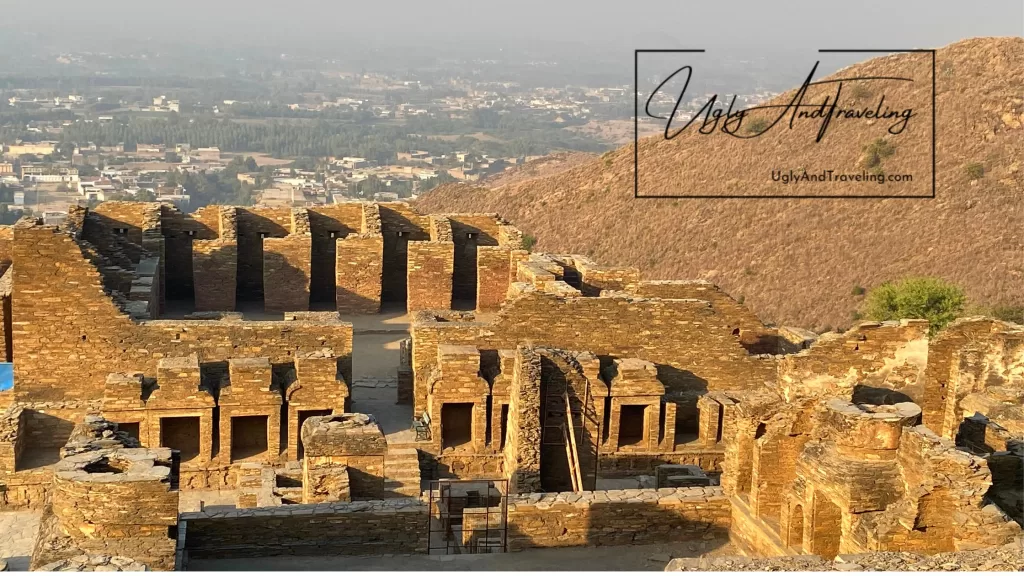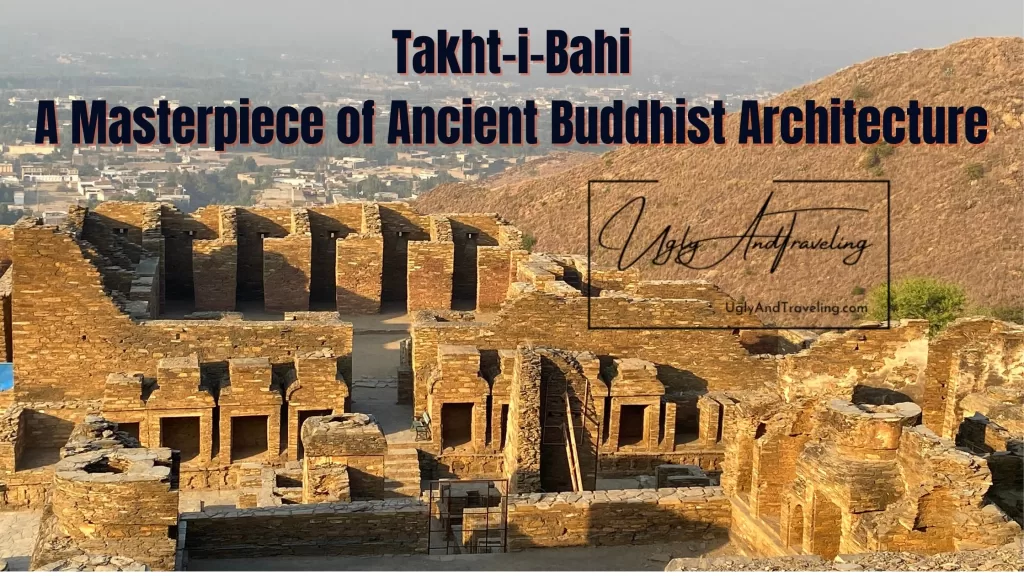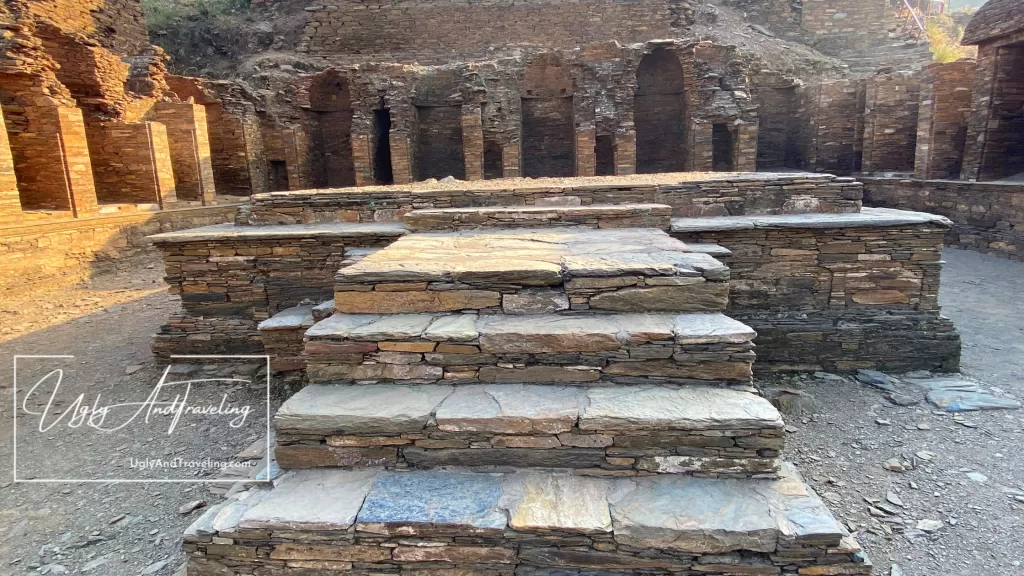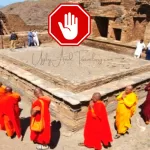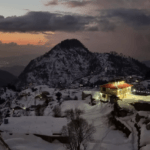The Ruins of Takht-i-Bahi, also known as the Throne of Origins, is a historical site located in the province of Khyber Pakhtunkhwa, Pakistan. This magnificent complex is considered one of the most well-preserved examples of Buddhist monastic architecture and is a testament to the rich cultural heritage of the region.
Explore the rich history and unique architecture of Takht-i-Bahi, a UNESCO World Heritage Site in Pakistan’s Khyber Pakhtunkhwa province. From its Buddhist origins to the blend of Buddhist and Islamic styles, discover the beauty of this hidden gem. Plan your visit with tips on how to reach the site, when to go, and what to expect.
A Glance into the History of Takht-i-Bahi
The monastery was built during the Gandhara era, a time when Buddhism flourished in the region. It is believed to have served as a center of learning and spiritual growth for Buddhist monks and scholars. Today, Takht-i-Bahi is a popular tourist destination and a revered site for Buddhists and historians alike.
Takht-i-Bahi was built during the 1st century AD and served as a Buddhist monastic complex for over a thousand years. The site was a hub of cultural, religious, and commercial activity, attracting Buddhist pilgrims and scholars from across the ancient world.
In the 7th century, the complex was abandoned due to the decline of Buddhism in the region and lay hidden for centuries until its rediscovery in the 19th century.
Located in the Khyber Pakhtunkhwa province, this UNESCO World Heritage Site is a symbol of rich history and architecture. If you’re planning a trip to Pakistan, Takht-i-Bahi should be at the top of your list. Let’s explore what makes this site so special and how you can plan a visit to this remarkable place.
The Architectural Wonders of Takht-i-Bahi
The ruins of Takht-i-Bahi are spread over a vast area, covering nearly 50 acres. The complex is comprised of a series of interconnected buildings, including meditation halls, stupas, shrines, and residential quarters.
One of the most striking features of the site is the grand staircase that leads up to the main shrine, offering breathtaking views of the surrounding landscape. The architectural style of Takht-i-Bahi is a blend of Greek, Indian, and local influences, creating a unique and distinct style.
The intricate carvings, intricate stonework, and subtle use of light and shadow are a testament to the skill of the artisans who built this magnificent complex.
Takht-i-Bahi is a magnificent example of ancient Buddhist architecture, featuring a complex of interconnected buildings and courtyards, surrounded by high walls and a massive gate. The main stupa, or dome-shaped structure, is a stunning example of ancient architectural techniques, and is considered one of the best preserved in the region.
The site is also home to a series of smaller stupas, as well as a number of monastic cells and meditation halls. Each building is adorned with intricate carvings and sculptures, showcasing the artistic skills of the ancient Gandharan people.
The architecture of Takht-i-Bahi is a unique blend of Buddhist and Islamic styles. The monastery is situated on a hilltop and is divided into three main parts: the Stupa Court, the Assembly Hall, and the Quadrangle.
The Stupa Court is the largest part of the monastery and contains the remains of several stupas. The Assembly Hall is where the monks used to gather for prayer and meditation, while the Quadrangle was used for administrative purposes.
The site is adorned with intricate carvings, sculptures, and frescoes that showcase the artistic and creative talent of the artisans of that era. The carvings on the pillars and walls depict scenes from Buddhist mythology and daily life in the monastery.
The Significance of Takht-i-Bahi
Takht-i-Bahi is not only a remarkable example of ancient architecture, but it also holds significant historical and cultural value. The site provides valuable insights into the daily life of Buddhist monks, their beliefs, and practices, and the role that religion played in shaping the ancient world.
Takht-i-Bahi is also a valuable resource for archaeologists and historians, as it contains artifacts and inscriptions that offer clues about the history of the region. The site is a symbol of the rich cultural heritage of Pakistan and a reminder of the importance of preserving our historical landmarks for future generations.
It is a testament to the rich cultural heritage of the region, and is considered a symbol of the flourishing of Buddhism in ancient times.
Takht-i-Bahi represents a critical chapter in the history of Buddhism in the region and serves as a testament to the religious, political, and economic developments of the time.
The site provides valuable insights into the daily life of the Buddhist monastic community, including the layout of the complex, the water supply system, and the architectural styles used in the construction of the buildings.
In addition, Takht-i-Bahi is a prime example of the cultural exchange that took place along the trade routes of the ancient world, showcasing the influence of different cultures and religions on each other.
For Buddhists, Takht-i-Bahi is a sacred site, and a place of pilgrimage. It is believed that visiting the site can bring spiritual fulfillment and connect one to the teachings of the Buddha.
The Decline of Takht-i-Bahi
By the 7th century CE, the decline of Buddhism in the region and the rise of Hinduism and Islam resulted in the gradual abandonment of Takht-i-Bahi. The site was eventually forgotten, and its ruins lay hidden for centuries, preserved by the dry climate of the region.
The Rediscovery of Takht-i-Bahi
In the late 19th century, British archaeologists rediscovered the ruins of Takht-i-Bahi, sparking a renewed interest in the site. Excavations were carried out, and many of the structures were restored to their original form. Today, Takht-i-Bahi is a popular tourist destination, attracting visitors from around the world.
A Must-Visit Destination
If you are visiting KPK (Pakhtunkhwa) Pakistan, do not miss to visit this incredible historical site. Visiting Takht-i-Bahi is a truly unique experience, offering a glimpse into the past and a chance to connect with the rich cultural heritage of the region. Whether you’re a history buff, an archaeologist, or simply looking for a new adventure, the Ruins of Takht-i-Bahi is for you.
How to Reach Takht-i-Bahi
Takht-i-Bahi is located near the city of Mardan in the Khyber Pakhtunkhwa province of Pakistan. The nearest airport is the Bacha Khan International Airport in Peshawar, which is about 50 kilometers from the site. From the airport, you can hire a taxi or take a bus to reach Takht-i-Bahi.
If you’re traveling from Islamabad, you can take a bus or hire a taxi to reach Takht-i-Bahi. The journey takes about four hours and is a scenic drive through the mountains.
When to Visit Takht-i-Bahi
The best time to visit Takht-i-Bahi is from October to March when the weather is pleasant and the site is less crowded. The site is open from 9 am to 5 pm, and the entrance fee is minimal.
Tips for Visiting Takht-i-Bahi
Here are some tips to help you plan your visit to Takht-i-Bahi:
- Wear comfortable shoes as the site involves a lot of walking and climbing stairs.
- Respect the local culture and dress modestly.
- Carry water and snacks as there are no restaurants or food stalls inside the site.
- Engage a local guide to get a better understanding of the site’s history and architecture.
- And do not miss reading the last paragraph, you must not do that if you want to visit Takht-i-Bahi
My Final Thoughts
The Ruins of Takht-i-Bahi offer a unique glimpse into the rich cultural heritage of ancient Pakistan. As a testament to the religious, political, and economic developments of the time, the site provides valuable insights into the daily life of the Buddhist monastic community and serves as a prime example of the cultural exchange that took place along the trade routes of the ancient world.
Visitors to Takht-i-Bahi will be transported back in time, as they explore the intricate details of the site and immerse themselves in the rich history of this ancient Buddhist monastic complex.
What I did not like in Takht-i-Bahi?
The staff at the entry point was not friendly, specially their manager or head (A guy called Mian Saab). I wrote a separate blog post about it, I would say DO NOT visit Takht-i-Bahi if you want to do this, read here!
You might like to read 🙂
50 Interesting Facts About Pakistan
The Ultimate Road Trip Survival Guide
10 Must Have Items for Your Next Road Trip
Safety Measures When Traveling in a Snowy Environment
A Quick Guide & Top 10 US Visa Interview Questions [Tips for Success]
If you found this blog helpful, It would be great if you could share it with your family and friends who might find it useful as well. Also you can join our traveler community and meet other travel lovers, share tips and travel experiences with each other.
Please subscribe to my YouTube channel “Ugly And Traveling” and watch 4K travel vlogs.
Stay safe and much love!
Traveling with the green 💚 passport
Take only memories✈️leave only footprints.
